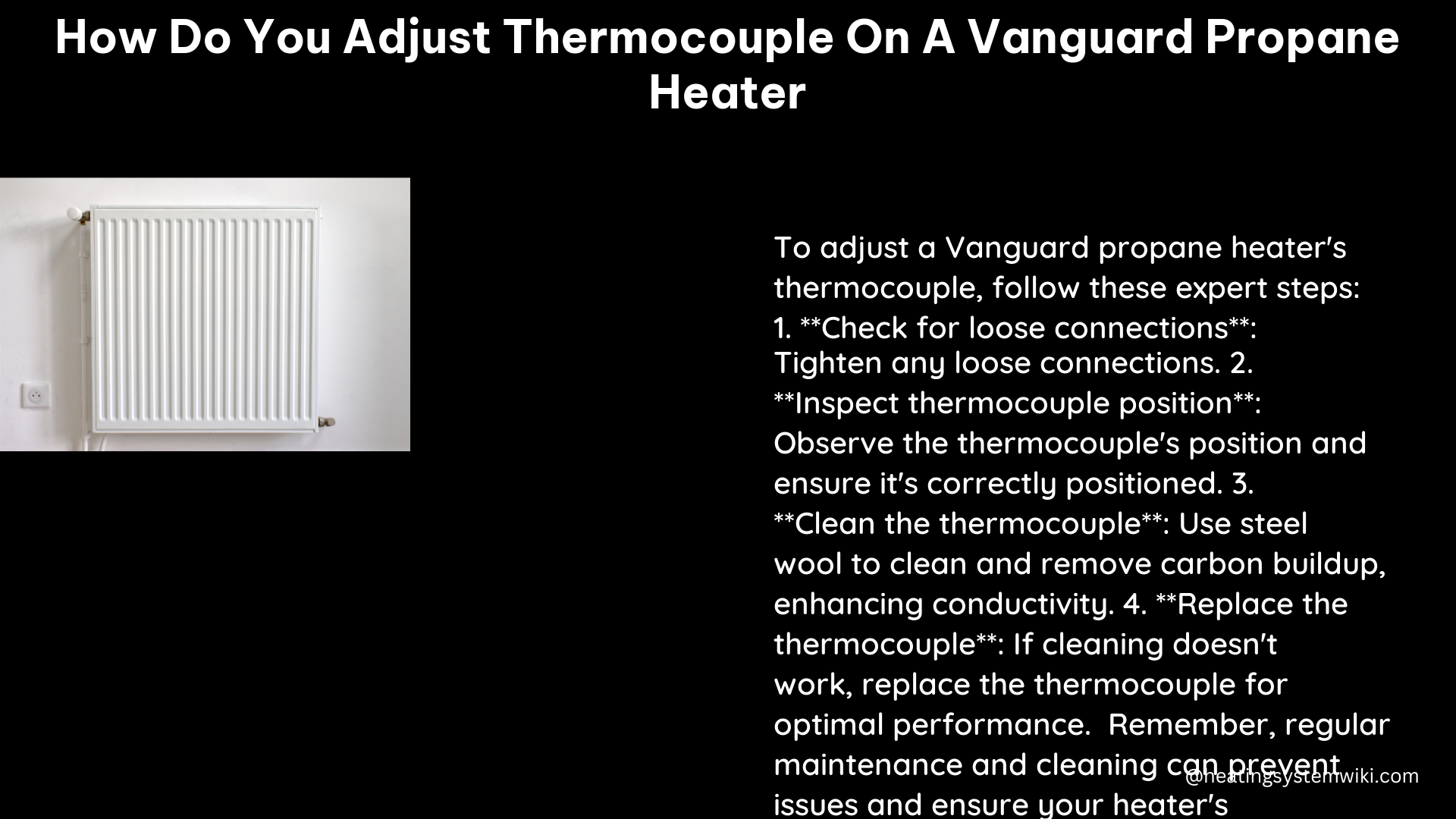Adjusting the thermocouple on a Vanguard propane heater is a crucial task that ensures the safe and efficient operation of your heating system. The thermocouple is a safety device that detects the presence of the pilot flame and shuts off the gas supply if the flame goes out. In this comprehensive guide, we’ll delve into the step-by-step process of adjusting the thermocouple, along with detailed technical specifications and a DIY-friendly approach to help you tackle this task with confidence.
Locating and Identifying the Thermocouple
The thermocouple on a Vanguard propane heater is typically located near the burner orifice, where the pilot flame is situated. It is a small, cylindrical device made of copper or brass, with a sensing tip composed of a thermoelectric material such as nickel-chromium alloy or iron-constantan alloy. The thermocouple has a diameter ranging from 1/8 inch to 3/16 inch and a length of approximately 39 inches.
When the pilot flame heats the thermocouple, it generates a small voltage (millivolts) that is used to operate the gas valve. This voltage is proportional to the temperature of the thermocouple, and it is this voltage that signals the gas valve to remain open and allow the flow of gas to the main burner.
Cleaning the Thermocouple

Before adjusting the thermocouple, it’s essential to clean it thoroughly to remove any dust, debris, or carbon deposits that may have accumulated over time. This can be done using a piece of fine-grained steel wool.
When cleaning the thermocouple, be gentle and avoid applying excessive force, as this can damage the delicate components. Gently rub the steel wool over the surface of the thermocouple, taking care to clean the entire length of the device.
Repositioning the Thermocouple
After cleaning the thermocouple, the next step is to reposition it in relation to the pilot flame. The thermocouple should be placed close to the pilot flame, but not touching it. The ideal positioning is at a 90-degree angle to the flame, with the sensing tip positioned approximately 1/4 inch to 1/2 inch from the flame.
It’s important to ensure that the thermocouple is securely in place and not loose, as a loose thermocouple can cause the heater to shut off unexpectedly. Use an adjustable wrench or pliers to gently tighten the thermocouple in its new position.
Testing the Heater
Once the thermocouple has been cleaned and repositioned, it’s time to test the heater to ensure that it is functioning correctly. Turn on the gas supply and ignite the pilot flame. Observe the heater to see if the main burner ignites and remains lit.
If the heater does not stay lit, there may be other issues that need to be addressed, such as a loose connection or a faulty thermocouple. In such cases, it’s best to consult the manufacturer’s instructions or seek the assistance of a professional HVAC technician.
Technical Specifications
The thermocouple used in a Vanguard propane heater is designed to meet specific technical requirements to ensure safe and reliable operation. Here are some key technical specifications:
- Material: Copper or brass body with a sensing tip made of thermoelectric material (nickel-chromium alloy or iron-constantan alloy)
- Diameter: 1/8 inch to 3/16 inch
- Length: Approximately 39 inches
- Voltage Output: Millivolts (mV) when heated by the pilot flame
- Operating Temperature Range: Typically between 40°F and 450°F (4.4°C and 232.2°C)
- Minimum Flame Sensing Temperature: Typically around 300°F (148.9°C)
DIY Guide: Adjusting the Thermocouple
To adjust the thermocouple on a Vanguard propane heater, you’ll need the following tools and materials:
- Steel wool
- Gloves
- Goggles
- Adjustable wrench
- Screwdriver
Here’s a step-by-step guide to adjusting the thermocouple:
-
Turn off the gas supply: Before starting the adjustment, ensure that the gas supply to the heater is turned off to prevent any potential safety hazards.
-
Locate the thermocouple: Identify the thermocouple and its position near the burner orifice.
-
Clean the thermocouple: Use the steel wool to gently clean the thermocouple, removing any dust, debris, or carbon deposits that may have accumulated.
-
Reposition the thermocouple: After cleaning, reposition the thermocouple so that it is close to the pilot flame but not touching it. The thermocouple should be positioned at a 90-degree angle to the flame, with the sensing tip approximately 1/4 inch to 1/2 inch from the flame.
-
Secure the thermocouple: Use an adjustable wrench or pliers to gently tighten the thermocouple in its new position, ensuring that it is securely in place and not loose.
-
Test the heater: Turn on the gas supply and ignite the pilot flame. Observe the heater to ensure that the main burner ignites and remains lit.
Remember, always follow the manufacturer’s instructions and guidelines when adjusting the thermocouple on a Vanguard propane heater. If you are not comfortable performing this task yourself, it’s best to seek the assistance of a professional HVAC technician.
